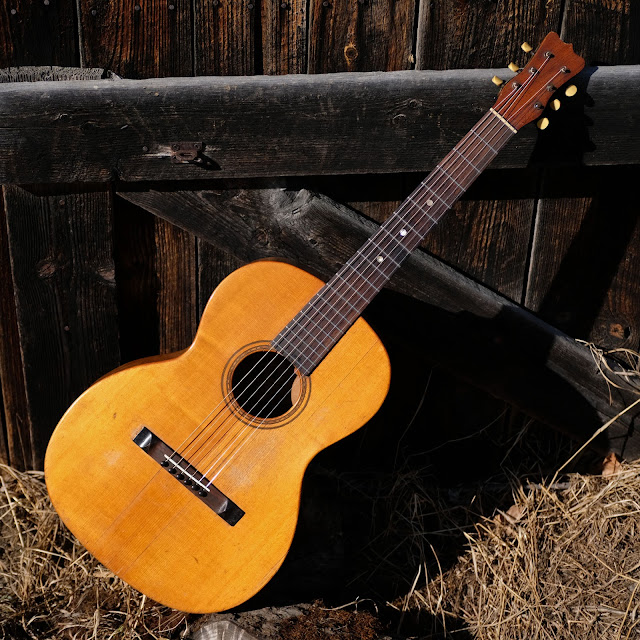1890s Joseph Bohmann 00-Size Flattop Guitar
While a previous 00-size Bohmann I worked-on had a tremendous sound and looked pretty spiffy, I think this Bohmann is the best one I've heard so far. Its outline is like a curvier Martin 00-18 12-fret from around the same period but it plays and sounds a lot like a good LG-2 from the '40s or early '50s mixed with that 12-fret Martin sound and lightness of build. Weird, right? It makes a perfect flatpicker despite being from a time when most guitars sounded lousy for traditional flatpicking. Even more surprising is the fullness of the tone derived only from 46w-10 extra light strings, too. These Bohmann guitars continue to surprise me!
This guy shares the same triple-x-braced pattern of that other 00-size Bohmann, but the guitar itself is a lot simpler in appointments. It has a solid spruce top and ply birdseye maple back and sides, a mahogany neck, and a 20" radiused rosewood fretboard and bridge.
Older work on it included some half-done crack repairs and OK seam repairs. My work was pretty extensive -- I cleated and sealed cracks where needed, reglued sections of loose seams, shaved the bridge, filled and relocated the saddle slot and pinholes, and planed the fretboard and refretted it with medium-large frets to rid the neck of a somewhat-frustrating warp that was in it. It's turned-out a perfect player with 3/32" EA and 1/16" DGBE action at the 12th fret. The neck is dead straight with the strings tuned to Eb (what you hear in the clip) and only budges a little over 1/64" tuned to pitch. I like to stay safe with oldies like this one so I've left it at Eb. The steel strings sound perfect on it, though.
Specs are: 25" scale, 1 7/8" nut width, 1 9/16" string spacing at the nut, 2 1/2" spacing at the bridge, 14 3/8" lower bout, 10 7/8" upper bout, and 4 1/8" depth at the endblock.
When Bohmann made the guitar, he ebonized the fretboard with whatever terrible agent folks were using back then to make them black. Over time it made the top layer of the board mealy and chip-prone, so one nice side-benefit of the necessary board plane was that the board was taken back down to just-below where the ebonization agent took effect. It feels a lot more classy to the touch (and the eye), now.
The center portion of the bridge had to come down quite a ways to correct action issues and also make room for the new (proper) saddle location. Note that I've redrilled the new pinholes on a line corresponding to the saddle. I figured Mr. Bohmann would've approved of some modernization in that respect -- as it keeps the back-angle similar string-to-string and resists splits along the pins a little bit more.
At first glance, the birdseye maple back looks truly fancy. Unfortunately, it's just veneer layered in the same way you see this stuff on German guitars from the time. The tone doesn't hurt from that ply rear, however!
The tuning machines are Bohmann's own design.














Comments